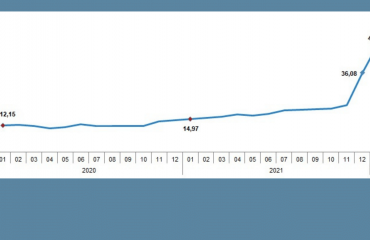

One of the most interesting – in fact, more correct to say weird – developments of the last week were the words of Şahap Kavcıoğlu, The Governor of the Turkish Central Bank (CBRT), who implied that from now they would focus on core inflation which excludes food and energy prices and alike. That would mean shifting away from the headline inflation concept triggering a reaction in the financial markets.
A monetary policy can focus on core inflation. That is not the weird part. I will come to that in a minute. But first, I would like to briefly explain the concept of core inflation and touch on its importance in monetary policy. Those who want to read “the weird part” as soon as possible can skip this slightly ‘technical’ part.
Core inflation is an option, but…
Central banks (with or without the government) announce an inflation target. The more credible this target is, the more strongly it shapes the pricing behavior of goods and services, wage negotiations, and interest rates. It also affects the exchange rate to some extent. These factors are already among the main determinants of the future values of inflation. In other words, it is desirable to shape future inflation by announcing the inflation target.
But there are different measures of inflation: Producer inflation, consumer inflation, or a subset of these. The reason for not targeting producer inflation is because it includes the prices of goods that consumers don’t take into account when making decisions; like aluminum plates, steel sheets.
On the other hand, the relationship between the prices of some goods and services in the consumer index and monetary policy can be very weak. For example, tomato prices decrease in summer and increase in winter. Moreover, if there is a frost or flood, the prices of all vegetables and fruits may increase.
It excludes most of the consumer prices
The prices of some goods and services depend on administrative decisions. A significant portion of the prices of tobacco products and alcoholic beverages in Turkey consists of taxes. Changes in tax rates change their prices.
If consumer inflation is targeted, the following drawback arises: Goods and services whose prices move independently of monetary policy can give the impression that inflation increases or decreases unnecessarily. However, the prices of goods and services on which monetary policy is effective can move in another direction. In this case, the central bank may feel compelled to react unnecessarily. Even if the central bank does not take any action, it should tell the public why it did not.
The way out of such a problem is to focus directly on ‘core inflation’ calculated from a subset of the consumer price index that excludes the prices of certain goods and services.
The drawback is this: Economic units also consume goods and services that are out of the core inflation indicator. Therefore, prices that are closely related to them are excluded. However, we want them to use the inflation target in their future contracts. But because of this exclusion, the target may become unimportant to them. Basically, with this concern, most central banks are targeting consumer inflation itself.
Here is the weird part: will the rates go up?
The following lines are from the Monetary Policy Committee (MPC) announcement on August 12:
* “The policy rate will continue to be determined at a level above inflation to maintain a strong disinflationary effect until strong indicators point to a permanent fall in inflation and the medium-term 5 percent target is reached.”
The crucial point is this: In its announcements, the CBRT says that it will keep the policy rate above inflation for a while. The MPC has increased the policy rate to 19% in March, and it has remained the same since then. However, the consumer inflation in August was announced as 19.25%.
If the CBRT keeps its promise in its announcements, it has to increase the policy rate at the MPC meeting on September 23.
However, one of the most difficult tasks in Turkey in recent years has been to raise the policy rate. In that case, engaging core inflation works. “I said I will keep it above inflation, but which inflation?” you say, and you start to emphasize core inflation.
Yes, you got it: since the core inflation is below 19%, the CBRT can shift to it.
Is the aim to force lowering the rates?
For example, the C index ‘excluding energy, food and non-alcoholic beverages, alcoholic beverages and tobacco products and gold’ indicates that the inflation is 16.8%. Therefore, the government and the CBRT can argue that there is no need to raise the policy rate.
Making such a statement by an institution whose credibility has diminished, and is undoubtedly not independent, is confusing.
The CBRT targets consumer inflation or headline inflation since January 2006. The question is, why shifting to core inflation now?
There is no technical answer to the question.
If such a shift is needed, at first, it should not be out of the blue; advance notice is necessary. Secondly, the reasons should be made public. Thirdly, such a turn should not be after the inflation rises to 19.25%. It should be after a significant drop in inflation so that you don’t give the impression that “the CBRT is taking a side road not to raise interest rates”.
What happens if you fail to obey these rules?
You hike the exchange rate by 2.2% and give way to another inflation wave.
From the crime scene: why it has not opted before?
So, why has consumer inflation been targeted since January 2006? Who chose this?
I took part in it as the Vice Chairman of the working group established at the CBRT in early 2005. This group spent most of 2005 with preparations for inflation targeting that would start in 2006.
There were two main reasons why we chose headline inflation:
First of all, unnecessary discussions that could damage the reputation of monetary policy, such as “the index that comes easy to choose”, were avoided. Secondly, a significant portion of the goods excluded by the core indicators had a determinate weight in the consumption baskets of the broad masses of the people. In this case, there was a danger of the inflation targets being ignored in the forward contracts.
Please pay attention to the timing: I’m talking about the period when inflation, which was 65% in mid-2001, fell steadily to 7.7% at the end of 2005.
Let me give you another criterion. While the end-2005 inflation target was 8%, the inflation expected by economists and market participants in the CBRT survey at the beginning of the year was 8.4%. Inflation was only 0.4 percentage points higher than the target. In other words, although there was significant confidence in the monetary policy, the CBRT administration then did not want to endanger its credibility and did not choose a target for core inflation.


